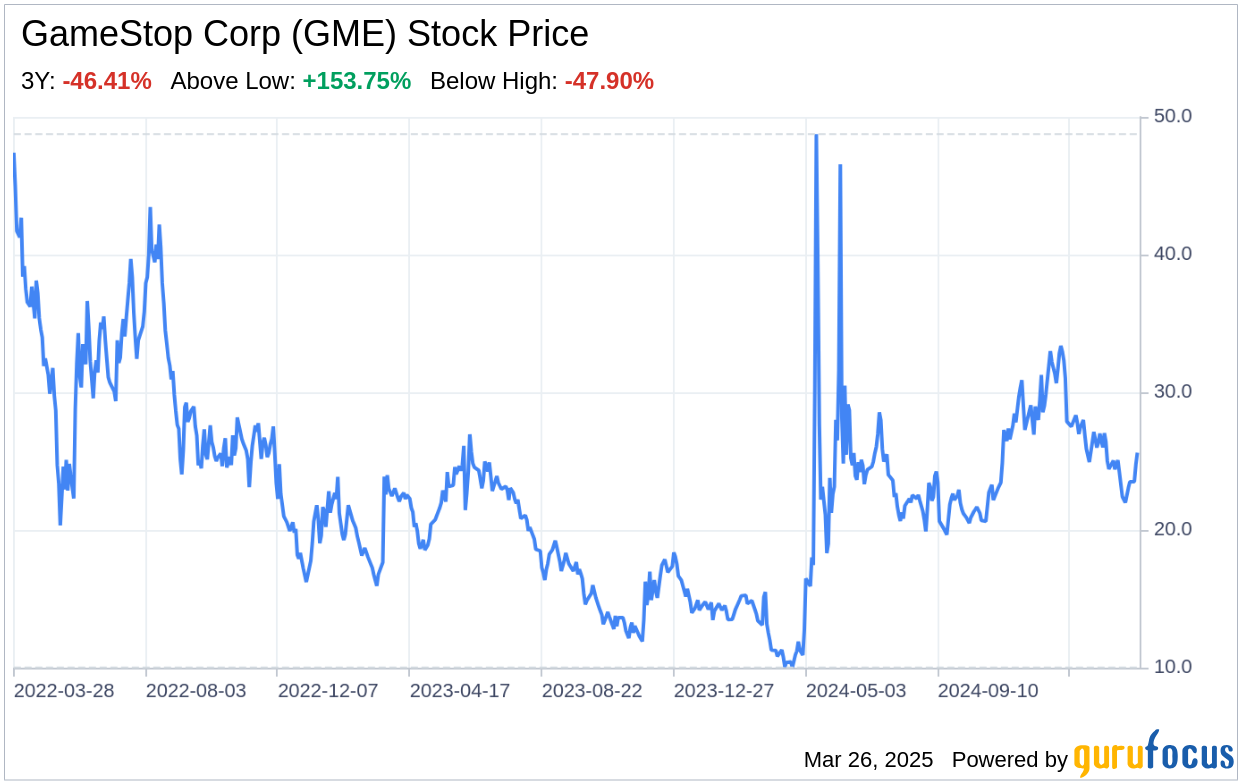On March 25, 2025, GameStop Corp (GME, Financial), a leading multichannel video game and consumer electronics retailer, released its annual 10-K filing, providing a comprehensive overview of its financial health and strategic positioning. With a fiscal year ending on February 1, 2025, GameStop reported a robust network of 3,203 stores globally, with a significant presence in the United States. Despite the challenges faced by brick-and-mortar retailers, GameStop's financial tables reflect resilience, with a market capitalization of approximately $8.2 billion as of August 2, 2024. The company's strategic focus on omnichannel retail excellence, cost optimization, and market expansion underpins its efforts to maintain profitability and shareholder value. This SWOT analysis delves into the strengths, weaknesses, opportunities, and threats that shape GameStop's current market position and future prospects.

Strengths
Brand Recognition and Loyalty: GameStop's brand is synonymous with gaming culture, boasting a loyal customer base and strong brand equity. The company's retail outlets, including GameStop, EB Games, and Micromania, are well-recognized by consumers, providing a competitive edge in the gaming and entertainment products market. This brand power is reinforced by exclusive memberships and loyalty programs, which encourage repeat business and customer retention.
Diverse Product Portfolio: GameStop's product mix includes hardware, software, and collectibles, catering to a wide range of consumer interests. The company's trade-in program further enhances its product offerings, allowing customers to exchange pre-owned items for new purchases. This diversity not only attracts various customer segments but also mitigates risks associated with product lifecycle fluctuations.
Physical and E-commerce Synergy: With a significant number of physical stores complemented by e-commerce platforms, GameStop provides a seamless omnichannel shopping experience. This synergy allows the company to leverage its physical presence for product launches, in-store events, and immediate customer service, while also capitalizing on the growing trend of online shopping.
Weaknesses
Dependence on Physical Retail: Despite efforts to bolster its e-commerce presence, GameStop's business model remains heavily reliant on physical stores. This dependence poses risks in an increasingly digital-centric market, where consumers favor online purchases and digital downloads over in-store transactions. The company must continue to adapt to this shift to avoid obsolescence and maintain market relevance.
Investment Strategy Risks: GameStop's investment policy, which includes the allocation of resources to cryptocurrencies like Bitcoin, introduces volatility and potential concentration risks. While this strategy may offer high returns, it also exposes the company to the unpredictable nature of cryptocurrency markets, which could impact financial stability and investor confidence.
Seasonality and Cyclical Nature: The gaming industry is characterized by seasonality, with a significant portion of GameStop's sales occurring during the holiday season. This cyclicality can lead to fluctuations in quarterly results and necessitates careful inventory and cash flow management to ensure year-round financial health.
Opportunities
Expansion into New Markets and Categories: GameStop has the opportunity to expand its addressable market by exploring new product and service offerings, such as graded collectibles. By tapping into emerging trends and consumer interests, the company can diversify its revenue streams and capture new customer segments.
Strategic Acquisitions and Partnerships: GameStop's investment policy provides the flexibility to pursue potential investment and acquisition opportunities. Strategic partnerships or acquisitions could enable the company to quickly adapt to technological advancements, expand its digital footprint, and enhance its product offerings.
Next-Generation Gaming Consoles: The introduction of new gaming platforms, such as the upcoming Nintendo Switch 2, presents an opportunity for GameStop to drive sales through hardware, software, and accessory offerings. Capitalizing on these product launches can bolster the company's market position and attract gaming enthusiasts.
Threats
Intense Competition: GameStop operates in a highly competitive retail landscape, facing pressure from multi-channel retailers, e-commerce giants, and direct-to-consumer offerings from console manufacturers. To remain competitive, the company must continuously innovate and offer compelling value propositions to consumers.
Digital Transformation of Gaming: The shift towards digital downloads and streaming services threatens GameStop's traditional business model. As consumers increasingly opt for digital content, the company's reliance on physical software sales and trade-ins could lead to declining revenues and market share.
Economic and Regulatory Uncertainties: Macroeconomic factors, such as interest rate changes, can impact GameStop's investment returns and liquidity. Additionally, regulatory developments concerning cryptocurrencies could affect the company's investment strategy and financial performance.
In conclusion, GameStop Corp (GME, Financial) possesses a strong brand presence and a diverse product portfolio that position it well within the gaming and entertainment retail sector. However, the company must navigate the challenges of a digital marketplace, competitive pressures, and the risks associated with its investment strategy. By capitalizing on opportunities for market expansion and technological innovation, GameStop can enhance its growth prospects. Conversely, threats from digital transformation and economic uncertainties require vigilant management and strategic foresight to ensure long-term success.
This article, generated by GuruFocus, is designed to provide general insights and is not tailored financial advice. Our commentary is rooted in historical data and analyst projections, utilizing an impartial methodology, and is not intended to serve as specific investment guidance. It does not formulate a recommendation to purchase or divest any stock and does not consider individual investment objectives or financial circumstances. Our objective is to deliver long-term, fundamental data-driven analysis. Be aware that our analysis might not incorporate the most recent, price-sensitive company announcements or qualitative information. GuruFocus holds no position in the stocks mentioned herein.
